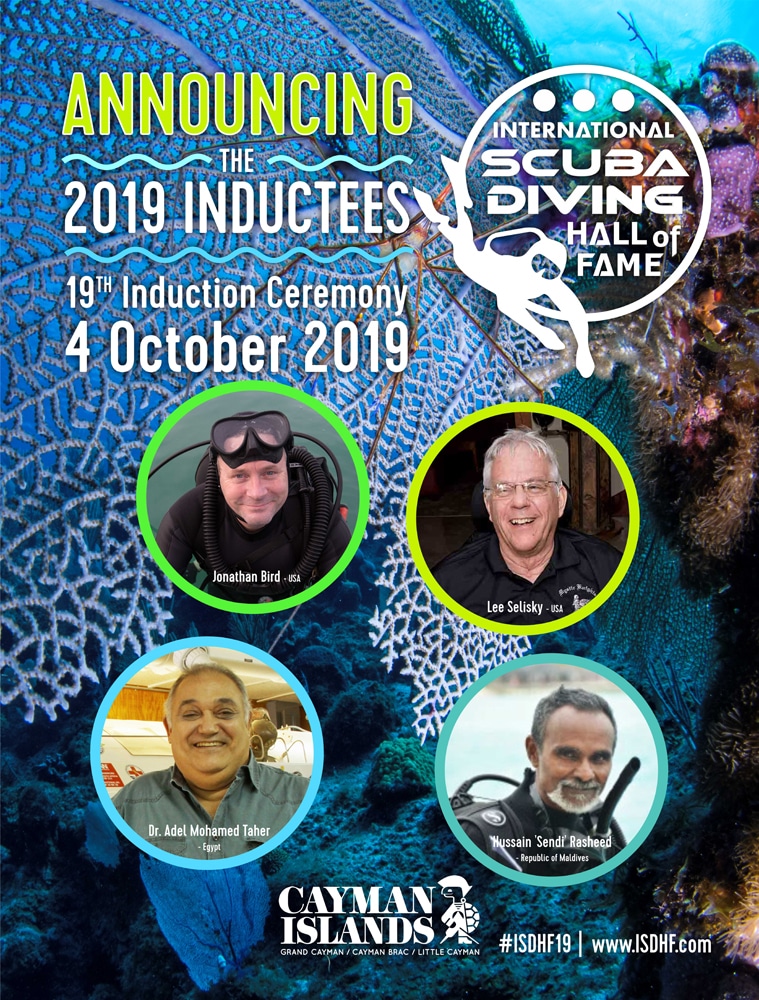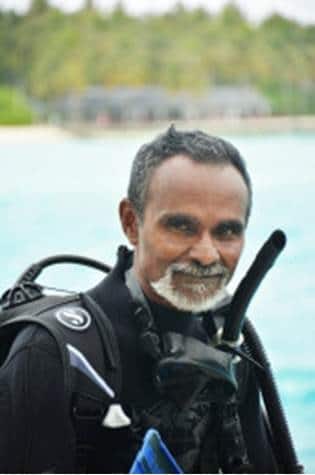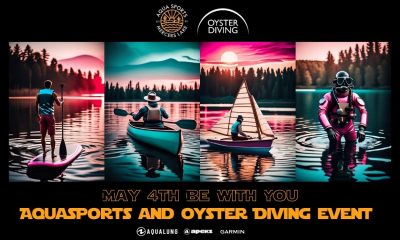News
The Cayman Islands “dive-ulges” new inductees for 2019 International Scuba Diving Hall of Fame

 Industry Pioneers and Lifelong Divers Recognized for their Achievements and Contributions to the Underwater Sport at Annual Ceremony in Grand Cayman
Industry Pioneers and Lifelong Divers Recognized for their Achievements and Contributions to the Underwater Sport at Annual Ceremony in Grand Cayman
The International Scuba Diving Hall of Fame (ISDHF) has announced four new members that will join the prestigious ranks of the 2019 Hall of Fame. As selected by the board of directors, the latest inductees include Jonathan Bird, Lee Selisky, Dr. Adel Mohamed Taher and Hussain ‘Sendi’ Rasheed, joining fellow esteemed dive industry pioneers who are taking the plunge to help cultivate and revolutionize the sport of scuba diving. On October 4, 2019, the new ISDHF members will be officially inducted into the 2019 Hall of Fame during an awards ceremony and dinner held in Grand Cayman, Cayman Islands.
Each year, the Cayman Islands welcomes new inductees as part of its ongoing support of the ISDHF. Established by the Cayman Islands Ministry of Tourism in 2000, the ISDHF celebrates those who have contributed positively to the success of recreational scuba diving worldwide through innovation and advancements made in the areas of dive tourism, equipment design, dive safety, education, exploration, adventure, innovation and more.
“After another record breaking 2018 for Cayman Islands tourism overall, our dive operators and partners project 2019 to be another exceptional year for the industry, which can be credited, in part, to the scuba diving pioneers and their historic legacies that have helped maintain our destination’s reputation as the leading spot to practice the sport of recreational diving,” said Hon. Minister of Tourism, Mr. Moses Kirkconnell.
“For nearly twenty years, the Cayman Islands continues to showcase some of the world’s greatest dive leaders through the International Scuba Diving Hall of Fame, highlighting their achievements and innovation for the industry, while allowing visitors to create long-lasting diving memories.”
The complete list of 2019 Inductees, along with a description of their unique contributions earning them the prestigious ISDHF accolade, is below:
Jonathan Bird (United States of America)
An Emmy Award-winning underwater cinematographer and producer, Jonathan Bird is best known as the founder of Oceanic Research Group, a non-profit environmental organization focused on educating people on the conservation of the world’s oceans. Working from this non-profit, he created “Jonathan Bird’s Blue World,” an educational family-friendly underwater science/adventure series that first aired on PBS in 2008. Now transitioned to YouTube, the series has become the most widely-watched scuba-themed program in the world with more than 109 million views, and 320,000 subscribers.
Along with his digital series, Bird has created and produced over 30 films for broadcast and education, which appeared on networks across the world including National Geographic Channel, PBS, ABC, USA Network, Discovery and the SciFi Channel. His productions, along with numerous books, have promoted ocean conservation efforts and made ocean research accessible and interesting to people across the world.
Lee Selisky (United States of America)
As a pioneer in manufacturing dive retail products, Selisky started his career in his garage building six-pound lead weight molds, which successfully evolved into Sea Pearls, the first company to introduce die-cast and vinyl coated weights into the industry. As a result of his successful business, Selisky gave back to the diving community by serving on many nonprofit boards, including being President of Diving Equipment and Marketing Association (DEMA), Founding Director of the ISDHF, multi-term Chairman of the Historical Diving Society (HDS), Director of the Original Ocean Futures Society, Director of the Hans Hass Award and Chairman of Divers Alert Network (DAN).
Using his personal philanthropy to “lead by example,” Selisky donated considerable amounts of money to these organizations as well as regional dive show fundraisers, marine environmental programs, and marine medical programs. In 2017, he also established the Lee Selisky Future Leaders in the Diving Industry Mentorship Program, for which Selisky legacy of service continues to inspire and support the recreational diving industry around the world.
Dr. Adel Mohamed Taher (Egypt)
Considered to be one of the top world experts in hyperbaric medicine, Dr. Adel Mohamed Taher is best known for establishing the most sophisticated diving medical facility in the Red Sea, which continues to provide a foundation of safety for the expanding dive tourism industry in the region and beyond. As a PADI Open Water Scuba Instructor since 1982, Dr. Taher has played a vital role in promoting diver safety in the Red Sea region by managing diving emergencies, participating in medical research projects and conferences, and acting as an advisor for governmental and non-governmental agencies.
Helping to catapult dive tourism in Egypt, Dr. Taher and his team worked with fellow dive professionals and local authorities to set and enforce diving safety regulations such as having oxygen onboard diving boats and worked closely with Divers Alert Network (DAN) to unify systems and protocols and establish the organization’s Egypt branch. In addition to Dr. Taher opening the first recompression chamber at the Hyperbaric Medical Center in Sharm el-Sheikh, which to this day has never refused a patient, he also served as the chief executive officer of Sharm Medical Group at Sinai Clinic Hospital.
Hussain ‘Sendi’ Rasheed (Republic of Maldives)
Known as “the Godfather of the Maldivian diving industry,” Hussain “Sendi” Rasheed was the first PADI Instructor Trainer in the Republic of Maldives and has since become a key figure in the region’s developing regulations surrounding marine health and diving tourism. Along with his extensive lobbying of all marine protected species and dive sites in the Maldives, Sendi received international media attention for organizing an underwater Cabinet Meeting, chaired by the President of the Republic of Maldives, to bring attention to the threat of global warming.
Sendi’s 37-year career shows his deep love of the ocean that he actively works to protect, as well as the impact of his educational efforts that has produced a continuing stream of savvy Maldivian Ocean Ambassadors. In recognition of his ongoing dedication and many efforts on behalf of diving and the marine environment, Sendi has also received both the Maldive Tourism Award and the Presidential Award.
To learn more about the 2019 ISDHF inductees, please click here.
Blogs
Northern Red Sea Reefs and Wrecks Trip Report, Part 3: The Mighty Thistlegorm

Jake Davies boards Ghazala Explorer for an unforgettable Red Sea diving experience…
Overnight, the wind picked up, making the planned morning dive a bit bumpy on the Zodiacs to the drop point on Thomas Reef. There, we would dive along the reef before descending through the canyon and then passing under the arch before ascending the wall with a gentle drift. The site provided great encounters with more pelagic species, including shoals of large barracuda, tuna, and bigeye trevally.
Once back on the boat, it was time to get everything tied down again as we would head back south. This time, with the wind behind us, heading to Ras Mohammed to dive Jackfish Alley for another great gentle drift wall dive before then heading up the coast towards the Gulf of Suez to moor up at the wreck of the Thistlegorm. This being the highlight wreck dive of the trip and for many onboard, including myself, it was the first time diving this iconic wreck. I had heard so much about the wreck from friends, and globally, this is a must on any diver’s list. Fortunately for us, there was only one other boat at the site, which was a rarity. A great briefing was delivered by Ahmed, who provided a detailed background about the wreck’s history along with all the required safety information as the currents and visibility at the site can be variable.

Kitting up, there was a lot of excitement on deck before entering the water and heading down the shoreline. Descending to the wreck, there was a light northerly current which reduced the visibility, making it feel more like the conditions that can be found off the Welsh coast. At 10m from the bottom, the outline of the wreck appeared as we reached the area of the wreck which had been bombed, as our mooring line was attached to part of the propeller shaft. Arriving on deck, instantly everywhere you looked there were many of the supplies which the ship was carrying, including Bren Carrier tanks and projectiles that instantly stood out.

We headed around the exterior, taking a look at the large propeller and guns mounted on deck before entering the wreck on the port side to take a look in the holds. It was incredible to see all the trucks, Norton 16H, and BSA motorcycles still perfectly stacked within, providing a real snapshot in time.

Overall, we had four dives on the Thistlegorm, where for all of the dives we were the only group in the water, and at times, there were just three of us on the whole wreck, which made it even more special, especially knowing that most days the wreck has hundreds of divers. Along with the history of the wreck, there was plenty of marine life on the wreck and around, from big green turtles to batfish, along with shoals of mackerel being hunted by trevally. Some unforgettable dives.

The final leg of the trip saw us cross back over the Suez Canal to the Gobal Islands where we planned to stay the night and do three dives at the Dolphin House for the potential of sharing the dive with dolphins. The site, which included a channel that was teeming with reef fish, especially large numbers of goatfish that swam in large shoals along the edge of the reef. These were nice relaxing dives to end the week. Unfortunately, the dolphins didn’t show up, which was okay as like all marine life they are difficult to predict and you can’t guarantee what’s going to be seen. With the last dive complete, we headed back to port for the final night where it was time to clean all the kit and pack before the departure flight the next day.

The whole week from start to finish on Ghazala Explorer was amazing; the boat had all the facilities you need for a comfortable week aboard. The crew were always there to help throughout the day and the chefs providing top quality food which was required after every dive. The itinerary providing some of the best diving with a nice mixture of wreck and reef dives. I would recommend the trip to anyone, whether it’s your first Red Sea liveaboard in the Red Sea or you’re revisiting. Hopefully, it’s not too long before I head back to explore more of the Red Sea onboard Ghazala Explorer.

To find out more about the Northern Red Sea reef and wrecks itineraries aboard Ghazala Explorer, or to book, contact Scuba Travel now:
Email: dive@scubatravel.com
Tel: +44 (0)1483 411590
Photos: Jake Davies / Avalon.Red
Blogs
Northern Red Sea Reefs and Wrecks Trip Report, Part 2: Wall to Wall Wrecks

Jake Davies boards Ghazala Explorer for an unforgettable Red Sea diving experience…
The second day’s diving was a day full of wreck diving at Abu Nuhas, which included the Chrisoula K, Carnatic, and Ghiannis D. The first dive of the day was onto the Chrisoula K, also known as the wreck of tiles. The 98m vessel remains largely intact where she was loaded with tiles which can be seen throughout the hold. The stern sits at 26m and the bow just below the surface. One of the highlights of the wreck is heading inside and seeing the workroom where the machinery used for cutting the tiles are perfectly intact. The bow provided some relaxing scenery as the bright sunlight highlighted the colours of the soft coral reef and the many reef fish.

Following breakfast, we then headed to the next wreck, which was the Carnatic. The Carnatic is an 89.9m sail steamer vessel that was built in Britain back in 1862. She ran aground on the reef back in 1869 and remains at 27m. At the time, she was carrying a range of items, including 40,000 sterling in gold. An impressive wreck where much of the superstructure remains, and the two large masts lay on the seafloor. The wooden ribs of the hull provide structures for lots of soft corals, and into the stern section, the light beams through, bouncing off the large shoals of glass fish that can be found using the structure as shelter from the larger predators that are found outside of the wreck.

The final wreck at Abu Nuhas was the Ghiannis D, originally called ‘Shoyo Maru,’ which was 99.5m long and built in Japan back in 1969 before becoming a Greek-registered cargo ship in 1980. The ship then ran aground on the reef on April 19th, 1983, and now sits at the bottom at a depth of 27m. Heading down the line, the stern of the ship remains in good condition compared to the rest of the hull. The highlight of the wreck, though, is heading into the stern section and down the flights of stairs to enter the engine room, which remains in good condition and is definitely worth exploring. After exploring the interior section of the ship, we then headed over to see the rest of the superstructure, where it’s particularly interesting to see the large table corals that have grown at the bow relatively quickly considering the date the ship sank. After surfacing and enjoying some afternoon snacks, we made sure everything was strapped down and secured as we would be heading north and crossing the Gulf of Suez, where the winds were still creating plenty of chop.

The next morning, it was a short hop to Ras Mohammed Nature Reserve for the next couple of days of diving. The 6am wake-up call came along with the briefing for the first site we would be diving, which was Shark & Yolanda. The low current conditions allowed us to start the dive at Anemone City, where we would drift along the steep, coral-filled wall. These dives involved drifts, as mooring in Ras Mohammed wasn’t allowed to protect the reefs. As a dive site, Shark & Yolanda is well-known and historically had a lot of sharks, but unfortunately not so many in recent years, especially not so early in the season. However, there was always a chance when looking out into the blue.

The gentle drift took us along the steep walls of the site, with plenty of anemone fish to be seen and a huge variety of corals. It wasn’t long into the dive before we were accompanied by a hawksbill turtle, who drifted with us between the two atolls before parting ways. Between the two reefs, the shallow patch with parts of coral heads surrounded by sand provided the chance to see a few blue-spotted stingrays that were mainly resting underneath the corals and are always a pleasure to see. With this being the morning dive, the early sunlight lit up the walls, providing tranquil moments. Looking out into the blue, there was very little to be seen, but a small shoal of batfish shimmering underneath the sunlight was a moment to capture as we watched them swim by as they watched us.

Towards the end of the dive, we stopped at the wreck of the Jolanda where the seafloor was scattered with toilets from the containers it was carrying. This provided a unique site to make a safety stop, which was also accompanied by a large barracuda slowly swimming by, along with a hawksbill turtle calmly swimming over the reef as the sun rays danced in the distance.
For the next dive, we headed north to the Strait of Tiran to explore the reefs situated between Tiran Island and Sharm El Sheik, which were named after the British divers who had found them. We started on Jackson before heading to Gordons Reef, where we also did the night dive. All the atolls at these sites provided stunning, bustling coral reefs close to the surface and steep walls to swim along, which always provided the opportunity to keep an eye out for some of the larger species that can be seen in the blue. Midwater around Jackson Reef was filled with red-toothed triggerfish and shoals of banner fish, which at times were so dense that you couldn’t see into the blue. Moments went by peacefully as we enjoyed the slow drift above the reef, watching these shoals swim around under the mid-afternoon sun.

The night dive at Gordon’s Reef was mainly among the stacks of corals surrounded by sand, which was great to explore under the darkness. After some time circling the corals, we came across what we were really hoping to find, and that was an octopus hunting on the reef. We spent the majority of the dive just watching it crawl among the reef, blending into its changing surroundings through changes in colour and skin texture. It’s always so fascinating and captivating to watch these incredibly intelligent animals, in awe of their ability to carry out these physical changes to perfectly blend into the reef. Before we knew it, it was time to head back to the boat to enjoy a well-deserved tasty dinner prepared by the talented chefs onboard.
Check in for the 3rd and final part of this series from Jake tomorrow!
To find out more about the Northern Red Sea reef and wrecks itineraries aboard Ghazala Explorer, or to book, contact Scuba Travel now:
Email: dive@scubatravel.com
Tel: +44 (0)1483 411590
Photos: Jake Davies / Avalon.Red
-

 News3 months ago
News3 months agoHone your underwater photography skills with Alphamarine Photography at Red Sea Diving Safari in March
-

 News3 months ago
News3 months agoCapturing Critters in Lembeh Underwater Photography Workshop 2024: Event Roundup
-

 Marine Life & Conservation Blogs2 months ago
Marine Life & Conservation Blogs2 months agoCreature Feature: Swell Sharks
-

 Blogs2 months ago
Blogs2 months agoMurex Resorts: Passport to Paradise!
-

 Blogs2 months ago
Blogs2 months agoDiver Discovering Whale Skeletons Beneath Ice Judged World’s Best Underwater Photograph
-

 Gear Reviews3 months ago
Gear Reviews3 months agoGear Review: Oceanic+ Dive Housing for iPhone
-

 Marine Life & Conservation2 months ago
Marine Life & Conservation2 months agoSave the Manatee Club launches brand new webcams at Silver Springs State Park, Florida
-

 News3 months ago
News3 months agoWorld’s Best Underwater Photographers Unveil Breathtaking Images at World Shootout 2023





















